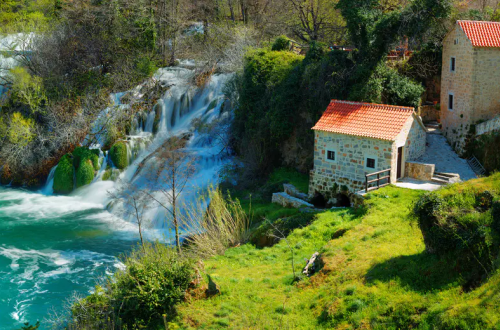

 Krka National Park
Krka National ParkThe next day we set out on one of the tour highlights to the National Park of Krka. Both this park and Plitvice which we visitied later in the week are just spectacular places to walk through, with waterfalls and fast flowing streams everywhere, and an abundance of wildlife. There’s a wide variety of both flora and fauna with over 800 species of plantlife that have been identified as being present in the Park. Every river had hundreds of fish swimming against the water flow and beautiful, blue winged dragonflies hovering over the reeds. We intruded on a bug having a bonk and wished we were in our swimming costumes underneath the waterfall as were a few locals.
Along the course of the river Krka there are about 30 water mills of whioh the best preserved is the mill at Skradinski buk. During the 14th and 15th centuries, the water mills on the Krka River were important for the entire Adriatic coast, as wheat was milled here for many towns including Dubrovnik. The mill at Skradinski buk includes a preserved water mill, a kitchen upstairs, the miller's flat and the stales; on the ground floor there are six milling wheels to grind the wheat to make bread. This is an obvious use of the many waterfalls formed along the Krka river; in one area just 400 m in length by 100 m wide there are 17 waterfalls and the total difference in height between the first and the last falls is 47.7 m. Skradinski buk sits at the bottom of this set of waterfalls.
 Sibenik
SibenikWe left Krka National Park having thoroughly enjoyed our time there and made our way to another town with history called Sibenik. Unlike other cities along the Adriatic coast, which were established by Greeks, Illyrians and Romans, Šibenik was founded by Croats although excavations of the castle of Saint Michael, have since proven that the place was inhabited long before the actual arrival of the Croats in the 10-11th century. Like many towns and cities in Croatia ownership has fluctuated over the centuries and most recently in the 2ndWW it was occupied by Italy and Germany. During the Croatian War of Independence (1991–1995), Šibenik was heavily attacked by the Serbs and although under-armed, the Croatian army and the people of Šibenik managed to defend the city and eventually they defeated the Serb forces and freed the occupied areas. Since then, the damaged areas of the city have been fully reconstructed.
At the time we were there a youth event was taking place (not sure what or why) and there were many yachts out on the water and the local children had painted self portraits which were hanging from the various buildings lining the streets; we thought this was a really nice touch. There are some interesting churches which have withstood the ravages of time. The 15th century church of St. John, built in the Gothic-Renaissance style, has a staircase erected next to the south side of the church leading to the chancel which was made by a Šibenik artist, Ivan Pribislavić. An interesting place to visit, given more time, but we thought with three tours arranged for the same day, either this or preferably the Zadar tour in the afternoon could have been omitted.
 Zadar
ZadarHowever, we did visit Zadar which on another day could have been very interesting but we were 'toured out' and opted to walk round the city by ourselves. Zadar is an important city and port not far away from Sibenik and although the old town is a few thousand years old with a network of very old narrow and charming city streets, as well as a Roman forum dating back to the first century AD we didn't see very much of the old part.
Instead we took a casual walk to the waterfront where people were relaxing, swimming and generally enjoying themselves and we saw and heard the 'sea organ'. This is a series of underwater pipes or tubes that make musical sounds as the waves ebb to and fro. Adjacent to this is a 'monument to the sun' which at night is purported to be quite spectacular (obviously we didn't see this but the image from the net shows what it would have been like).
We saw the Church of St. Donatus which was built by Donatus of Zadar, who began construction in the 9th century; originally named Church of the Holy Trinity it was re-dedicated to St. Donatus in the 15th century. The church is worth a mention as it is the largest pre-romanesque building in Croatia.